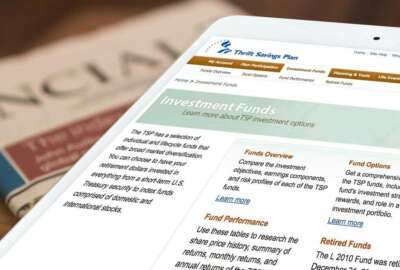
Why many outside investors envy your TSP
When you leave government are you going to keep your optional retirement nest egg in the Thrift Savings Plan, or move some or all of it to an outside investment...
When you leave government are you going to keep your optional retirement nest egg in the Thrift Savings Plan? Or, like many, will you move some or all of it to an outside investment option, maybe one that gives you more choices?
And does it matter?
Years ago I had the pleasure of spending about an hour with John C. Bogle. He’s the father of the index fund and founder of Vanguard. He died in January 2019 as one of the most successful investors in history.
There was nothing I could tell him, except how our coffee machine worked — that I could handle. But he told me a lot, including that he wished he could get into the TSP.
Why? He liked the choices available to investors and he liked the management. But his favorite thing about the TSP were its low administrative fees, at that time the lowest in the business. That’s what you are charged by whoever manages your investments. Bogle, who was no penny-pincher, said that over time, especially with a large investment, administrative fees can eat into your investment big time. Important for anybody, but especially for people with large accounts.
Recently several readers have asked about the difference in fees between the TSP and outside investment options. I checked with Kim Weaver, director of external affairs for the Federal Retirement Thrift Investment Board, and here’s what she said:
Read more: Technology News
“This is the information we have on our website about TSP expenses — we direct participants to this information on their statements:
| Expenses by Fund | ||||||||||
| L 2050 |
L 2040 |
L 2030 |
L 2020 |
L Income |
G Fund |
F Fund |
C Fund |
S Fund |
I Fund |
|
| 2019 Administrative Expenses | ||||||||||
| Gross | .052% | .052% | .052% | .053% | .053% | .053% | .052% | .052% | .052% | .052% |
| Net | .042% | .042% | .042% | .042% | .042% | .043% | .042% | .042% | .042% | .042% |
| 2019 Other Expenses | ||||||||||
| .005% | .005% | .004% | .002% | .001% | .000% | .004% | .001% | .018% | .007% | |
“We’ve been asked about how the TSP’s administrative fees compare to those of other defined contribution plans. It is impossible to make an exact comparison. When attempting to compare expenses, it is important to keep several things in mind:
- Gross vs. net administrative expenses: The TSP’s administrative expenses are partially offset by forfeitures and loan fees. In 2019, the gross administrative expense ratio was 5.2 basis points, but forfeitures and loan fees brought the net administrative expense ratio down to 4.2 basis points. Many defined contribution plans report ‘record-keeping fees,’ which are analogous to the TSP’s net administrative expenses. An industry expert tells us that large plans (those with more than 15,000 participants) typically report record-keeping fees in the range of 5-6 basis points.
- Administrative expenses vs. investment management expenses: 4.2 basis points reflects the TSP’s net administrative expenses. The TSP also pays fees to its asset manager to cover investment management, securities lending, and custody and administrative services. These are referred to as ‘investment management expenses,’ and they averaged (across the five funds) approximately 0.4 basis points in 2019 [see table above]. The investment management expenses for other plans can vary widely, depending on plan size and the combination of active and passive strategies in the investment lineup. An industry expert tells us that many plans have investment management expenses in the range of 25-30 basis points.
- Total plan fees: The sum of net administrative expenses and investment management fees represents the total plan fees. In 2019, the TSP’s total plan fees were approximately 4.6 basis points (4.2 basis points in net administrative expenses + 0.4 basis points in investment management expenses). An industry expert reports that total plan fees across the defined contribution industry have a median of approximately 37 basis points. Among plans with more than 15,000 participants, total plan fees have a median of approximately 32 basis points.
“We want our participants to be fully informed of the expenses and fees that they are paying in the TSP. I hope this explanation is helpful.”
Nearly Useless Factoid
By Amelia Brust
For anyone unattached this Valentine’s Day and feeling bad about it, maybe it’s not you, it’s your address? ApartmentList.com ranked Provo, Utah, as the best metropolitan area in the country for dating, 45 miles south of Salt Lake City. The ranking was based on the number of survey responders who said they were satisfied with their town’s dating scene — Provo-ites were about 47.5% satisfied. By comparison, the three worst metros were all in Florida: North Port, Deltona and Lakeland.
Source: ApartmentList.com
Copyright © 2025 Federal News Network. All rights reserved. This website is not intended for users located within the European Economic Area.
Mike Causey is senior correspondent for Federal News Network and writes his daily Federal Report column on federal employees’ pay, benefits and retirement.
Follow @mcauseyWFED




